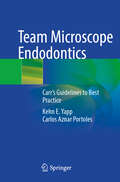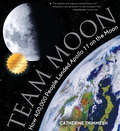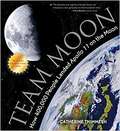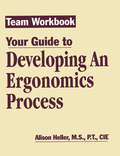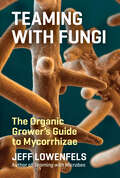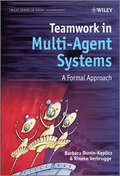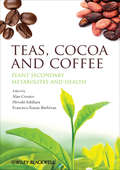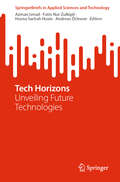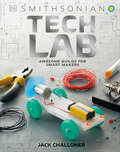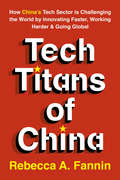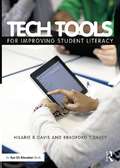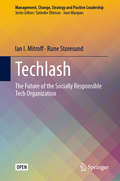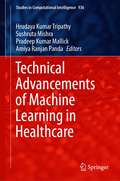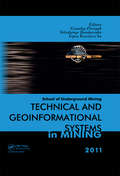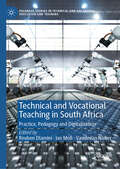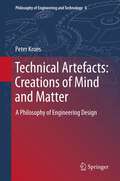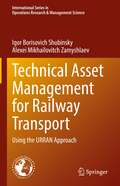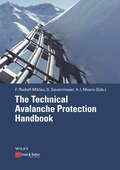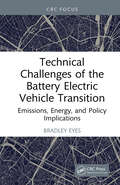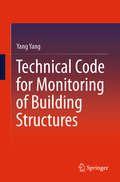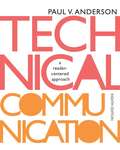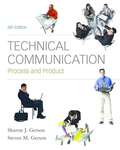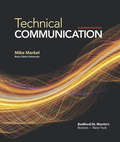- Table View
- List View
Team Microscope Endodontics: Carr’s Guidelines to Best Practice
by Kehn E. Yapp Carlos Aznar PortolesThis book is a complete guide on how to use a microscope as a team for all endodontic procedures. Readers will learn how to create an environment where every clinical task is done efficiently with the highest level of teamwork. All foundational principles are covered including how to design a surgery, choose a microscope setup, position the equipment, train an assistant, perform all procedures using the microscope and - most important of all - develop expertise. Sample plans and training guides are discussed. By following the provided outline, both operators and assistants can learn all the skills for team microscope endodontics. Whilst this is mainly written for endodontic postgraduates and endodontists, other dentists who want to become experts in microscope use will find the book valuable.
Team Moon: How 400,000 People Landed Apollo 11 on the Moon
by Catherine Thimmesh&“This behind-the-scenes look at the first Apollo moon landing has the feel of a public television documentary in its breadth and detail&” (Publishers Weekly, starred review). Here is a rare perspective on a story we only thought we knew. For Apollo 11, the first moon landing, is a story that belongs to many, not just the few and famous. It belongs to the seamstress who put together twenty-two layers of fabric for each space suit. To the engineers who created a special heat shield to protect the capsule during its fiery reentry. It belongs to the flight directors, camera designers, software experts, suit testers, telescope crew, aerospace technicians, photo developers, engineers, and navigators. Gathering direct quotes from some of these folks who worked behind the scenes, Catherine Thimmesh reveals their very human worries and concerns. Culling NASA transcripts, national archives, and stunning NASA photos from Apollo 11, she captures not only the sheer magnitude of this feat but also the dedication, ingenuity, and perseverance of the greatest team ever—the team that worked to first put man on that great gray rock in the sky. Winner of the Robert F. Sibert Informational Book Award &“An edge-of-your-seat adventure . . . Lavishly illustrated . . . This exhilarating book . . . will captivate.&” —Chicago Sun-Times &“Thimmesh gives names and voices to the army that got Neil Armstrong and company to the moon and back. The result is a spectacular and highly original addition to the literature of space exploration.&” —The Horn Book &“This beautiful and well-documented tribute will introduce a new generation to that triumphant time.&” —Kirkus Reviews (starred review)
Team Moon: How 400,000 People Landed Apollo 11 on the Moon
by Catherine ThimmeshFor the kids of all those thousands and thousands of people who worked on Apollo. For the sacrifices you made--the birthday parties, ballgames, and bedtime stories that your parents had to miss because the moon was calling, and demanding their time. It must have been hard sometimes. But look at what they did! Thanks for sharing them with the world when we needed them most.<P><P> Winner of the Sibert Medal
Team Workbook-Your Guide To Developing An Ergonomics Process
by Alison Heller-OnoThis workbook is designed to be used as part of the Developing an Ergonomics Process system. It can be used as a tool, helping the reader to implement strategies effectively, as the process of reducing workplace injuries and illnesses is outlined and effected.
Teaming with Fungi: The Organic Grower's Guide to Mycorrhizae (Science For Gardeners Ser.)
by Jeff LowenfelsFrom the bestselling author of Teaming with Microbes and Teaming with Nutrients Teaming with Fungi is an important guide to mycorrhizae and the role they play in agriculture, horticulture, and hydroponics. Almost every plant in a garden forms a relationship with fungi, and many plants would not exist without their fungal partners. By better understanding this relationship, gardeners can take advantage of the benefits of fungi, which include an increased uptake in nutrients, resistance to drought, earlier fruiting, and more. Learn how the fungi interact with plants and how to best to employ them in your home garden.
Teamwork in Multi-Agent Systems
by Barbara Dunin-Keplicz Rineke VerbruggeWhat makes teamwork tick?Cooperation matters, in daily life and in complex applications. After all, many tasks need more than a single agent to be effectively performed. Therefore, teamwork rules!Teams are social groups of agents dedicated to the fulfilment of particular persistent tasks. In modern multiagent environments, heterogeneous teams often consist of autonomous software agents, various types of robots and human beings.Teamwork in Multi-agent Systems: A Formal Approach explains teamwork rules in terms of agents' attitudes and their complex interplay. It provides the first comprehensive logical theory, TeamLog, underpinning teamwork in dynamic environments. The authors justify design choices by showing TeamLog in action.The book guides the reader through a fascinating discussion of issues essential for teamwork to be successful:What is teamwork, and how can a logical view of it help in designing teams of agents? What is the role of agents' awareness in an uncertain, dynamic environment? How does collective intention constitute a team? How are plan-based collective commitments related to team action? How can one tune collective commitment to the team's organizational structure and its communication abilities? What are the methodological underpinnings for teamwork in a dynamic environment? How does a team and its attitudes adjust to changing circumstances? How do collective intentions and collective commitments arise through dialogue? What is the computational complexity of TeamLog? How can one make TeamLog efficient in applications? This book is an invaluable resource for researchers and graduate students in computer science and artificial intelligence as well as for developers of multi-agent systems. Students and researchers in organizational science, in particular those investigating teamwork, will also find this book insightful. Since the authors made an effort to introduce TeamLog as a conceptual model of teamwork, understanding most of the book requires solely a basic logical background.
Teas, Cocoa and Coffee: Plant Secondary Metabolites and Health
by Alan CrozierIn recent years, the role of plant secondary metabolites as protective constituents in the human diet has been a growing area of research. Unlike the traditional vitamins, they are not essential for short-term wellbeing, but there is increasing evidence that modest long-term intakes can have favourable impacts on the incidence of cancers and many chronic diseases, including cardiovascular disease and type II diabetes, which are occurring in Western populations with increasing frequency. This book covers the latest science on the metabolism and potential health benefits of teas, cocoa, coffee and their extracts in the human diet. From an opening chapter tracing the origins of teas, cocoa and coffee as beverage, the book proceeds to explore the phytochemical content of coffee, cocoa and the various types of tea. The bioavailability of secondary metabolites from each of the beverages is then considered in depth, and related directly to their health benefits. Embracing the full range of tea, coffee and cocoa beverages and products, the book offers the most up-to-date and comprehensive treatment of these increasingly important dietary components. As the only book to bring together the latest information on the biochemistry and health benefits of teas, coffee and cocoa, this book is essential reading for food scientists and technologists involved in the production of tea, coffee and cocoa products. Nutritionists will value the book's health focus, while agricultural scientists working on the cultivation of these crops will prize its scope and depth of detail. It is also an important resource for all those who use functional ingredients in other products, whether they are based in industry or research.
Tech Horizons: Unveiling Future Technologies (SpringerBriefs in Applied Sciences and Technology)
by Andreas Öchsner Azman Ismail Fatin Nur Zulkipli Husna Sarirah HusinThis book assembles a varied array of chapters, each delving into a distinct aspect of innovation and its practical applications. Readers will explore cutting-edge technologies and applicable techniques that aimed at enhancing academic performance. "Tech Horizon" provides an enthralling exploration of the diverse and transformative vistas within the domain of modern technology.
Tech Lab: Awesome Builds for Smart Makers (DK Activity Lab)
by Jack ChallonerThis DK children's book for ages 11-14 is brimming with exciting, educational activities and projects that focus on electronics and technology.Keep your siblings out of your room with a brilliant bedroom alarm, power a propellor motorboat, make a thermoelectric phone charger, build a set of speakers, and construct a crane by following step-by-step instructions and using affordable equipment. Tech Lab will engage budding scientists and engineers as they experiment, invent, trial, and test technology, electronics, and mechanics at home.Simple steps with clear photographs take readers through the stages of each low-cost project, with fact-filled panels to explain the science behind each one, and to fascinate them with real-world examples.With an increasing focus across school curricula on encouraging children to explore STEM subjects (science, technology, engineering, and maths), Tech Lab is the perfect companion for any inquisitive child with an interest in how the worlds of science experiments and technology work, and why."
Tech Request: A Guide for Coaching Educators in the Digital World
by Emily L. Davis Brad CurrieIn this much-needed book, experts Emily L. Davis and Brad Currie draw on their extensive experience in coaching and instructional technology and provide concrete, research-based strategies to help coaches in their day-to-day role. Whether you’re beginning a coaching initiative or looking for practical insights on coaching in a variety of settings, including in groups and one-to-one, you’ll find the resources you need to overcome challenges and grow your coaching skills. Topics include: The basics of tech coaching How to clarify on the expectations and objectives of your role Tips for recruiting teachers to work with you Guiding educators in planning and implementing meaningful technology integration How to plan and facilitate effective team coaching Strategies to gather and share data to communicate the impact of your coaching work How to stay ahead of the curve and keep learning for the future Every chapter includes practical tools, templates, and illustrative vignettes from the field to help you ensure the success of your technology coaching initiative. Join the conversation! Discuss the book and your coaching questions on Twitter with the hashtag #TechRequestEDU.
Tech Titans of China: How China's Tech Sector is challenging the world by innovating faster, working harder, and going global
by Rebecca FanninThe rise of China's tech companies and intense competition from the sector is just beginning. This will present an ongoing management and strategy challenge for companies for many years to come. Tech Titans of China is the go-to-guide for companies (and those interested in competition from China) seeking to understand China's grand tech ambitions, who the players are and what their strategy is. Fannin, an expert on China, is an internationally-recognized journalist, author and speaker. She hosts 12 live events annually for business leaders, venture capitalists, start-up founders, and others impacted by or interested in cashing in on the Chinese tech industry. In this illuminating book, she provides readers with the ammunition they need to prepare and compete. Featuring detailed profiles of the Chinese tech companies making waves, the tech sectors that matter most in China's grab for super power status, and predictions for China's tech dominance in just 10 years.
Tech Tools for Improving Student Literacy
by Bradford T. Davey Hilarie B. DavisTechnology isn’t just fun to use in the classroom, it can also make real improvements in students’ literacy development. In this book, authors Hilarie Davis and Bradford Davey show you how and why to use tech tools to help enhance the teaching of reading, writing, speaking, listening, and viewing. These tools can be used in English/Language Arts and across the subject areas to promote literacy throughout your school. Special Features: Practical classroom examples from a variety of content areas Connections to specific Common Core State Standards "Using the Technology" boxes with step-by-step guidance on using a tool Screenshots that show how the tools work Strategies to help you use the tools effectively with students
Techlash: The Future of the Socially Responsible Tech Organization (Management, Change, Strategy and Positive Leadership)
by Ian I. Mitroff Rune StoresundTechnology has made human lives incomparably better. Civilization as we know it would utterly collapse without it. However, if not properly managed, technology can and will be systematically abused and misuse and thereby become one of the biggest threats to humankind. This open access book applies proactive crisis management to the management of technology organizations to make them more sustainable and socially responsible for the betterment of humankind. It forecasts the unintended consequences of technology and offers methods to counteract it.
Technen: Elements of Recent History of Information Technologies with Epistemological Conclusions
by Andrzej Piotr WierzbickiThe book expresses the conviction that the art of creating tools - Greek techne - changes its character together with the change of civilization epochs and co-determines such changes. This does not mean that tools typical for a civilization epoch determine it completely, but they change our way of perceiving and interpreting the world. There might have been many such epochs in the history of human civilization (much more than the three waves of agricultural, industrial and information civilization). This is expressed by the title Technen of the book, where n denotes a subsequent civilization epoch. During last fifty years we observed a decomposition of the old episteme (understood as a way of creating and interpreting knowledge characteristic for a given civilization epoch) of modernism, which was an episteme typical for industrial civilization. Today, the world is differently understood by the representatives of three different cultural spheres: of strict and natural sciences; of human and social sciences (especially by their part inclined towards postmodernism) and technical sciences that have a different episteme than even that of strict and natural sciences. Thus, we observe today not two cultures, but three different episteme. The book consists of four parts. First contains basic epistemological observations, second is devoted to selected elements of recent history of information technologies, third contains more detailed epistemological and general discussions, fourth specifies conclusions. The book is written from the cognitive perspective of technical sciences, with a full awareness - and discussion - of its differences from the cognitive perspective of strict sciences or human and social sciences. The main thesis of the book is that informational revolution will probably lead to a formation of a new episteme. The book includes discussions of many issues related to such general perspective, such as what is technology proper; what is intuition from a perspective of technology and of evolutionary naturalism; what are the reasons for and how large are the delays between a fundamental invention and its broad social utilization; what is the fundamental logical error (using paradoxes that are not real, only apparent) of the tradition of sceptical philosophy; what are rational foundations and examples of emergence of order out of chaos; whether civilization development based on two positive feedbacks between science, technology and the market might lead inevitably to a self-destruction of human civilization; etc.
Technical Advancements of Machine Learning in Healthcare (Studies in Computational Intelligence #936)
by Hrudaya Kumar Tripathy Sushruta Mishra Pradeep Kumar Mallick Amiya Ranjan PandaThis book focuses on various advanced technologies which integrate with machine learning to assist one of the most leading industries, healthcare. It presents recent research works based on machine learning approaches supported by medical and information communication technologies with the use of data and image analysis. The book presents insight about techniques which broadly deals in delivery of quality, accurate and affordable healthcare solutions by predictive, proactive and preventative methods. The book also explores the possible use of machine learning in enterprises, such as enhanced medical imaging/diagnostics, understanding medical data, drug discovery and development, robotic surgery and automation, radiation treatments, creating electronic smart records and outbreak prediction.
Technical and Geoinformational Systems in Mining: School of Underground Mining 2011
by Genadiy Pivnyak Volodymyr Bondarenko Iryna Kovalevs’kaNew trends of mineral deposits mining in the world consist of intensifying and concentration of mining operations. This is achieved with the help of new technical equipment that is more reliable, having greater service life and more available power. Consideration is given to quantity reduction of stopes and development workings together with t
Technical and Vocational Teaching in South Africa: Practice, Pedagogy and Digitalisation (Palgrave Studies in Technical and Vocational Education and Training)
by Reuben Dlamini Ian Moll Vasidevan NaikerThis book unpacks the notion of pedagogy in South African technical and vocational education and training (TVET), enhancing the importance of the psychological dimension of learning. The book is premised on the idea that as stories of actual, grounded teaching and learning practices emerge from South African colleges, a coherent picture of pedagogy can be established. With chapters by practising TVET educators writing about their own work, the volume seeks to reconceptualise vocational teaching and learning processes with diversity and inclusivity in mind. The book will be of interest to students and scholars of TVET and education in South Africa, as well as South African college practitioners and policymakers.
Technical Artefacts: Creations of Mind and Matter
by Peter KroesThis book presents an attempt to understand the nature of technical artefacts and the way they come into being. Its primary focus is the kind of technical artefacts designed and produced by modern engineering. In spite of their pervasive influence on human thinking and doing, and therefore on the modern human condition, a philosophical analysis of technical artefacts and engineering design is lacking. Among the questions addressed are: How do technical artefacts fit into the furniture of the universe? In what sense are they different from objects from the natural world, or from the social world? What kind of activity is engineering design and what does it mean to say that technical artefacts are the embodiment of a design? Does it make sense to consider technical artefacts to be morally good or bad by themselves because of the way they influence human life? The book advances the thesis that technical artefacts, conceived of as physical constructions with a technical function, have a dual nature; they are hybrid objects combining physical and intentional features. It proposes a theory of technical functions and technical artefact kinds that does justice to this dual nature, analyses engineering design from the dual nature point of view, and argues that technical artefacts, because of their dual nature, have inherent moral significance.
Technical Asset Management for Railway Transport: Using the URRAN Approach (International Series in Operations Research & Management Science #322)
by Igor Borisovich Shubinsky Alexei Mikhailovitch ZamyshlaevThis book introduces readers to the key provisions of the URRAN-based technical asset management system - a methodology for managing resources and risks by analyzing and ensuring the required levels of reliability and safety in Russia’s railway transport facilities. It describes the architecture of the URRAN information system’s unified corporate platform (UCP URRAN) and its subsystems for infrastructure facilities and rolling stock complexes. It also highlights the UCP URRAN’s prospects for development, especially in the application of artificial intelligence to predict dangerous events in railway transport operation. The book is chiefly intended for specialists engaged in practical work on the technical maintenance of railway transport facilities. It can also be used as a reference guide for students and researchers at railway universities or professionals who are dealing with problems in technical asset management in other industries.
The Technical Avalanche Protection Handbook
by Monica Boensch Arthur Mears Florian Rudolf-Miklau Siegfried SauermoserSnow avalanches can have highly destructive consequences in developed areas. Each year, avalanche catastrophes occur in mountain regions around the globe and cause unnecessary fatalities and severe damage to buildings and infrastructure. In some mountainous regions, especially in the European Alps, technical avalanche defence structures are built to increase the level of safety for inhabited areas; however, new infrastructure such as roads, railway lines and tourist facilities cause new risk potential in hazardous areas. As a result, the demand is increasing for technical avalanche protection solutions. Avalanche defence structures and protection systems are used in most inhabited mountain regions worldwide. During the last decades, technical avalanche protection has evolved from a specialist field to an independent engineering branch that has gained importance in alpine countries such as Austria, Italy, France and Switzerland, as well as in other countries such as Canada, Iceland, Norway and USA. This work is the first comprehensive, English-language overview of technical avalanche protection and establishes state-of-the-art best practices in the field. It covers the fundamentals of avalanche protection technology and includes plans, dimensions, construction and maintenance of defence structures. The editors have collaborated with an international team of experts from Austria, Canada, France, Iceland, Italy, Japan, Norway, Switzerland and USA to produce this landmark handbook.
Technical Challenges of the Battery Electric Vehicle Transition: Emissions, Energy, and Policy Implications
by Bradley EyesThis practical guide identifies the technical challenges of transitioning to battery electric vehicles in Australia, reviews the impacts of life cycle emissions on passenger transport systems, and presents government, institutional and personal requirements for reducing passenger vehicle mode share.Accommodating renewable energy sources to achieve emission reductions following a 1.5°C pathway laid out by the Intergovernmental Panel on Climate Change (IPCC) will require a significant reduction in transport energy demand. This book guides the reader through multiple necessary approaches, including demand reduction, significant holistic efficiency increases, and technology adoption that progresses beyond physical transport options. The scope is for the medium to long-term, addressing the complex challenges of battery electric vehicle sales regulation and disposal to 2050. Successful examples and policies from around the world are reviewed to showcase necessary societal changes to support a transition to sustainable transport in cities. The book provides readers with a fundamental technical understanding of passenger transport energy demand and necessary emissions reduction solutions. Applying this knowledge is fundamental in decision-making for sustainable transport solutions.This accessible and practical shortform book provides information necessary for policy-makers, transport industry professionals, and interested sustainability researchers. Although the discussion and focus are on Australian cities, the cases described, policies analyzed, and recommendations made are applicable to any developed city worldwide.
Technical Code for Monitoring of Building Structures
by Yang YangThis book is used as a reference book for researcher and engineer of the world to learn the building monitoring standard of China for the first time, and is also be used as a reference manual for engineer to engage in practical monitoring projects. The standard for project construction of “Technical Code for Monitoring of Building Structures in Qinghai Province” is the first standard for building structure monitoring engineering in China, which integrates design, construction and acceptance of monitoring technique. It can be applied to any place in the world not limited to Qinghai. The standard specifies the warning thresholds for various building structure monitoring parameters. In the monitoring technology, advanced monitoring technologies such as structure group, cloud platform, and BIM are adopted. It has strong operability for monitoring building structures according to the requirement of the standard, provides technical support for ensuring the safety of building structure, and fills in the blank of building structure safety monitoring technology in high and cold high-altitude areas. It contains specific measures to implement housing security for the first time, which is one of the “two without worries and three guarantees” proposed by General Secretary Xi Jinping. It is also used as a reference book for senior undergraduate and graduate students in colleges and universities.
Technical Communication: A Reader-Centered Approach (Eigthth Edition)
by Paul V. AndersonThe book intends to improve the students' writing and design skills.Also includes new learning outcomes at the start of each chapter to help students gain more from their reading.
Technical Communication: Process and Product (6th edition)
by Sharon J. Gerson Steven M. GersonThis 6th edition of Technical Communication: Process and Product guides readers through the entire writing process -- pre-writing, writing, and rewriting -- developing an easy-to-use, step-by-step technique for writing the types of documents they will encounter on the job.
Technical Communication
by Mike MarkelInstructors know that Mike Markel's Technical Communication will prepare their students for any workplace writing situation. No other text offers such a comprehensive introduction to the field while still delivering practical, effective support for students at every level. The eleventh edition has been thoroughly revised to reframe the work of technical communicators in the context of today's highly collaborative, rapidly evolving digital practices. Fresh, social-media driven sample documents and coverage of the latest tools and technologies ensure that students work with the kinds of processes and products they'll encounter on the job.
